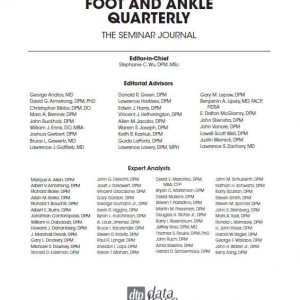30-3 Geriatric Medicine in Podiatry
$88.00
Editorial
» I have been around podiatry long enough to witness how social change and advances in podiatric education and surgery form an...
It has been an honor to contribute to the Foot and Ankle Quarterly journal. When asked to choose a focus for this issue, I paused only for a moment before suggesting that the practice of podiatric medicine with geriatric patients would be a topic of great importance for readers.
I have been around podiatry long enough to witness how social change and advances in podiatric education and surgery form an interconnected web of expertise that’s normalized podiatrists’ roles in primary medicine. This, for many reasons, couldn’t have been envisioned a few decades ago.
In the 1970s, podiatrists became sports medicine physicians, answering the needs of the hundreds of thousands of new and seasoned runners and other athletes. In the 1980s and beyond, as the epidemic of diabetes was fully manifested, podiatrists again joined in battling a complex medical challenge, developing foundational research on the diabetic limb and becoming the physicians most responsible for limb and life-saving treatments for millions of wounded and amputated patients.
Today, we face a new demographic challenge: the rise of the geriatric population – a cohort which is often affected by not only diabetes, but the complex set of co-morbidities and expectations that can accompany it. There is an ever-increasing hope (if not a certainty) that function, mobility, activity and recreation can and should be maintained and enhanced well into the seventh and eighth decades of life.
The data is clear – a sedentary lifestyle kills. Sitting is the new smoking. To whom will those who have trouble staying on their feet turn? Who can enhance and promote pain-free ambulation? Who can apply surgical and non-surgical methods to resolve dermatologic, mechanical and orthopaedic pathologies that stifle daily activities of living? And, who can impact the rising statistics related to falling, from which consequences can be so grave? This issue is devoted to answering these questions and exploring the ways that podiatrists’ roles are expanding in improving the quality and duration of patients’ lives.
I would like to thank my many gifted colleagues and associates at the New York College of Podiatric Medicine for their perspectives and time contributed to this work.
Robert A. Eckles, DPM, MPH
Description
In This Issue:
- FEATURE ARTICLE: The Podiatrist as Primary Care Physician
Robert A. Eckles, DPM, MPH - CONDENSATIONS/COMMENTARIES
- Demographic Turning Points for the United States: Population Projections for 2020 to 2060
Commentary by Robert A. Eckles, DPM, MPH - The Population Prevalence of Foot and Ankle Pain in Middle and Old Age: A Systematic Review
Commentary by Anthony R. Iorio, DPM - Age-Associated Skin Conditions and Diseases: Current Perspectives and Future Options
Commentary by Anthony R. Iorio, DPM - Polypharmacy in the Elderly
Commentary by Allan M. Jacobs, DPM - Biomechanics of the Aging Foot and Ankle: A Mini-Review
Commentary by Jeffrey J. Cusack, DPM - Do Plantar Hyperkeratoses Affect Balance in People Older than 65 Years Old?
Commentary by Loretta Logan, DPM - Foot Problems as a Risk Factor for Falls in Community-Dwelling Older People: A Systematic Review and Meta-Analysis
Commentary by Robert A. Eckles, DPM, MPH - Effectiveness of a Multifaceted Podiatry Intervention to Prevent Falls in Community-Dwelling Older People with Disabling Foot Pain: Randomized Controlled Trial
Commentary by Loretta Logan, DPM - ACS NSQIP®/AGS Best Practice Guidelines: Optimal Pre-Operative Assessment of the Geriatric Surgical Patient
Commentary by Reem Sheikh, DPM - Complication Rates and Short-Term Outcomes after Operative Hammer-Toe Correction in Older Patients
Commentary by Kevin Jules, DPM - American College of Surgeons Geriatric Trauma Management Guidelines
Commentary by Reem Sheikh, DPM - Ankle Fractures in the Elderly: Risks and Management Challenges
Commentary by Thomas D. Vitale, DPM - Standardized Pre-Operative Diagnostics and Treatment of Peripheral Arterial Disease Reduce Wound Complications in Geriatric Ankle Fracture
Commentary by Thomas D. Vitale, DPM
- Demographic Turning Points for the United States: Population Projections for 2020 to 2060
- AUDIO LECTURE 1: Adult Acquired Flatfoot Deformity
Kevin T. Jules, DPM - AUDIO LECTURE 2: The Pathomechanics of Geriatric Gait
Robert A. Eckles, DPM, MPH


